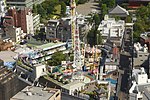Asakusa Shrine
AsakusaBuildings and structures in TaitōGongenImportant Cultural Properties of JapanShinbutsu bunri ... and 1 more
Shinto shrines in Tokyo

Asakusa Shrine (浅草神社, Asakusa-jinja) is a Shinto shrine located in the Asakusa district of Tokyo, Japan. Also known as Sanja-sama (Shrine of the Three gods), it is one of the most famous Shinto shrines in the city. The shrine honors the three men who founded the Sensō-ji. Asakusa Shrine is part of a larger grouping of sacred buildings in the area. It can be found on the east side of the Sensō-ji down a street marked by a large stone torii. One of the only two buildings in the area to survive World War II, it is designated an Important Cultural Property due to its long history.
Excerpt from the Wikipedia article Asakusa Shrine (License: CC BY-SA 3.0, Authors, Images).Asakusa Shrine
Kototoi-dori, Taito Asakusa
Geographical coordinates (GPS) Address Nearby Places Show on map
Geographical coordinates (GPS)
| Latitude | Longitude |
|---|---|
| N 35.715138888889 ° | E 139.79743611111 ° |
Address
幣殿
Kototoi-dori
111-0033 Taito, Asakusa
Japan
Open on Google Maps










